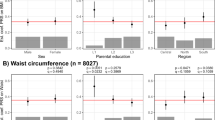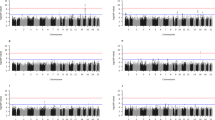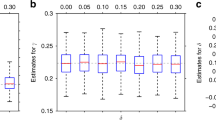Abstract
Objective:
The phenotypic heterogeneity of metabolic syndrome (MSX) suggests heterogeneity of the underlying genotype. The aim of the present study was to examine the common genetic background that contributes to the clustering between the two main features (insulin resistance, central obesity) and different MSX component traits.
Methods:
In all, 492 individuals from 90 families were investigated in a three-generation family path study as part of the Kiel Obesity Prevention Study (KOPS, 162 grandparents, 66.1±6.7 years, 173 parents, 41.3±5.4 years and 157 children, 10.8±3.4 years). Overall heritability was estimated and common familial (genetic and environmental) influences on insulin resistance (HOMA-IR) or central obesity (elevated waist circumference, WC), respectively, and different MSX traits were compared in a bivariate cross-trait correlation model.
Results:
Prevalence of MSX (according to NCEP criteria) was 27.2% (f) and 27.8% (m) in adults and 3.5% (f) and 8.5% (m) in children and adolescents, respectively. MSX phenotype was found to be highly variable, comprising 16 subtypes of component trait combinations. Within-trait heritability was 38.5% for HOMA-IR and 53.5% for WC, cross-trait heritability was 53.4%. As much as 6–18% and 3–10% of the shared variance between different MSX component traits (lipid profile, blood pressure) and WC or HOMA-IR, respectively, may be genetic. With the exception of HDL-C, the shared genetic variance between MSX component traits and WC was higher than the genetic variance shared with HOMA-IR.
Conclusion:
A common genetic background contributes to the clustering of different MSX component traits and central obesity or insulin resistance. Common genetic influences favour central obesity as a major characteristic linking these traits.
This is a preview of subscription content, access via your institution
Access options
Subscribe to this journal
Receive 12 print issues and online access
$259.00 per year
only $21.58 per issue
Buy this article
- Purchase on Springer Link
- Instant access to full article PDF
Prices may be subject to local taxes which are calculated during checkout
Similar content being viewed by others
References
Reaven GM . Banting lecture: role of insulin resistance in human disease. Diabetes 1988; 37: 1595–1607.
Kekalainen P, Sarlund H, Pyorala K, Laakso M . Hyperinsulinemia cluster predicts the development of type 2 diabetes independent of a family history of diabetes. Diabet Care 1999; 22: 86–92.
Report of a WHO Consultation. In: Alwan A, King H (eds) Definition, Diagnosis and Classification of Diabetes mellitus and its Complications. Part 1: Diagnosis of Classification of Diabetes mellitus. World Health Organization, Department of Noncommunicable Disease Surveillance: Geneva, 1991. pp 1–59.
Balkau B, Charles MA . Comment on the provisional report from the WHO consultation. European Group for the Study of Insulin Resistance (EGIR). Diabet Med 1999; 16: 442–443.
Expert Panel on Detection, Evaluation, and Treatment of High Blood Cholesterol in Adults. Executive Summary of the third Report of the National Cholesterol Education program (NCEP) (Adult Treatment Panel III). JAMA 2001; 285: 2486–2497.
The IDF consensus worldwide definition of the metabolic syndrome International Diabetes Federation, published online in April 2005 at http://www.idf.org/webdata/docs/IDF_Metasyndrome_definition.pdf.
Kuuisto J, Lempiainen P, Mykkanen L, Laakso M . Insulin resistance syndrome predicts coronary heart disease in elderly type 2 diabetic men. Diabet Care 2001; 24: 1629–1633.
Ferrannini E, Haffner SM, Mitchell BD, Stern MP . Hyperinsulinemia: the key feature of a cardiovascular and metabolic syndrome. Diabetologia 1991; 34: 416–422.
Liese AD, Mayer-Davis EJ, Tyroler HA, Davis CE, Keil U, Duncan BB et al. Development of the multiple metabolic syndrome in the ARIC Cohort: joint contribution of insulin, BMI, and WHR. Ann Epidemiol 1997; 7: 407–416.
Kendall DM, Hamel AP . The metabolic syndrome, type 2 diabetes, and cardiovascular disease: understanding the role of insulin resistance. Am J Manage Care 2002; 8: S635–S653.
Reusch JE . Current concepts in insulin resistance, type 2 diabetes mellitus, and the metabolic syndrome. Am J Cardiol 2002; 90: 19G–26G.
Maison P, Byrne CD, Hales CN, Day NE, Wareham NJ . Do different dimensions of the metabolic syndrome change together over time? Evidence supporting obesity as the central feature. Diabet Care 2001; 24: 1758–1763.
Han TS, Williams K, Sattar N, Hunt KJ, Lean ME, Haffner SM . Analysis of obesity and hyperinsulinemia in the development of the metabolic syndrome: San Antonio Heart Study. Obes Res 2002; 10: 923–931.
Lorenzo C, Okoloise M, Williams K, Stern MP, Haffner SM . The metabolic syndrome as a predictor of type 2 diabetes. The San Antonio Heart Study. Diabet Care 2003; 26: 3153–3159.
Palaniappan L, Carnethon MR, Wang Y, Hanley AJG, Fortmann SP, Haffner SM et al. Predictors of the incident metabolic syndrome in adults. The Insulin Resistance Atherosclerosis Study. Diabet Care 2004; 27: 788–793.
Arya R, Blangero J, Williams K, Almasy L, Dyer TD, Leach RJ et al. Factors of insulin resistance syndrome-related phenotypes are linked to genetic locations on chromosomes 6 and 7 in nondiabetic Mexican-Americans. Diabetes 2002; 51: 841–847.
Lindgren CM, Mahtani MM, Widen E, McCarthy MI, Daly MJ, Kirby A et al. Genomwide search for type 2 Diabetes mellitus susceptibility loci in Finnish families: The Botnia Study. Am J Hum Genet 2002; 70: 509–516.
McQueen MB, Bertram L, Rimm EB, Blacker D, Santangelo SL . A QTL genome scan of the metabolic syndrome and its component traits. BMC Genet 2003; 4 (Suppl 1): S96–S100.
Rice T, Nadeau A, Perusse L, Bouchard C, Rao DC . Familial correlations in the Quebec family study: cross-trait familial resemblance for body fat with plasma glucose and insulin. Diabetologia 1996; 39: 1357–1364.
Carmelli D, Cardon LR, Fabsitz R . Clustering of hypertension, diabetes and obesity in adult male twins: same genes or same environments? Am J Hum Genet 1994; 55: 566–573.
Mitchell BD, Kammerer CM, Mahaney MC, Blangero J, Comuzzie AG, Atwood LD et al. Genetic analysis of the IRS: pleiotropic effects of genes influencing insulin levels on lipoprotein and obesity measures. Arterioscler Thromb Vasc Biol 1996; 281–288.
Hong Y, Pedersen NL, Brismar K, de Faire U . Genetic and environmental achitecture of the features of the insulin-resistance syndrome. Am J Hum Genet 1997; 60: 143–152.
Hong Y, Rice T, Gagnon J, Despres J-P, Nadeau A, Perusse L et al. Familial clustering of insulin and abdominal visceral fat. The HERITAGE Family Study. J Clin Endocrinol Metab 1998; 83: 4239–4245.
Müller MJ, Asbeck I, Mast M, Langnäse K, Grund A . Prevention of obesity-more than an intention. Concept and first results of the Kiel Obesity Prevention study (KOPS). Int J Obes 2001; 25 (Suppl 1): S66–S74.
Danielzik S, Czerwinski-Mast M, Langnäse K, Dilba B, Müller MJ . Parental overweight, socioeconomic status and high birth weight are the major determinants of overweight and obesity in 5-7-y-old children: baseline data of the Kiel Obesity Prevention Study (KOPS). Int J Obes 2004; 28: 1494–1502.
Kromeyer-Hauschild K, Wabitsch M, Kunze D, Geller F, Geiß HC, Hesse V et al. Perzentile für den Body-Mass-Index für das Kindes- und Jugendalter unter Heranziehung verschiedener deutscher Stichproben. Monatsschr Kinderheilkd 2001; 149: 807–8118.
WHO Obesity. preventing and managing the global epidemic. WHO, Technical report Series No. 894, WHO Geneva, 2000.
Bosy-Westphal A, Mast M, Eichhorn C, Becker C, Kutzner D, Heller M et al. Validation of air-displacement plethysmography for estimation of body fat mass in healthy elderly subjects. Eur J Nutr 2003; 42 (4): 207–216.
Siri WE . Body composition from fluid spaces and density: analysis of methods. In: Brozek J and Henschel A (eds). Techniques for measuring body composition. National Academy of Sciences: Washington, DC, 1961. pp 223–244.
Bosy-Westphal A, Danielzik S, Becker C, Geisler C, Onur S, Korth O et al. There is need for optimal body composition data analysis using Air-Displacement Plethysmography in children and adolescents. J Nutr 2005; 135: 2257–2262.
Matthews DR, Hosker JP, Rudenski AS, Naylor BA, Treacher DF, Turner RC . Homeostasis model assessment: insulin resistance and beta-cell function from fasting plasma glucose and insulin concentrations in man. Diabetologia 1985; 28: 412–419.
Frederiks AM, Van Buuren S, Fekkes M, Verloove-Vanhorick SP, Wit JM . Are age references for waist circumference, hip circumference and waist-hip ratio in Dutch children useful in clinical practice? Eur J Pediatr 2005; 164: 216–222.
SM Grundy, Brewer HB, Cleeman JI, Smith SC, Lenfant C, for the Conference Participants. Definition of Metabolic Syndrome Report of the National Heart, Lung, and Blood Institute/American Heart Association Conference on Scientific Issues Related to Definition. Circulation 2004; 109: 433–438.
American Academy of Pediatrics, Task Force on Blood Pressure Control in Children. Report on the Second Task Force on Blood Pressure Control in Children – 1987. Pediatrics 1987; 79: 1–25.
Eckel RH, Grundy SM, Zimmet PZ . The metabolic syndrome. Lancet 2005; 365: 1415–1428.
Freeman MS, Mansfield MW, Barrett JH, Grant PJ . Heritability of features of insulin resistance syndrome in a community-based study of healthy families. Diabet Med 2002; 19: 994–1000.
Mills GW, Avery PJ, McCarthy MI, Hattersley AT, Levy JC, Hitman GA et al. Heritability estimates for beta cell function and features of the insulin resistance syndrome in UK families with an increased susceptibility to type 2 diabetes. Diabetologia 2004; 47: 732–738.
Allard P, Delvin EE, Paradis G, Hanley JA, O’Loughlin J, Lavallee C et al. Distribution of fasting plasma insulin, free fatty acids and glucose concentrations and of homeostasis model assessment of insulin resistance in a representative sample of Quebec children and adolescents. Clin Chem 2003; 49: 644–649.
Acknowledgements
The study was financed by a grant from the Bundesministerium für Forschung und Technologie, Netzwerk Molekulare Ernährung, Nahrungsfette und Genvariabilität, Teilprojekt 6.1.2. There are no conflicts of interest.
Author information
Authors and Affiliations
Corresponding author
Rights and permissions
About this article
Cite this article
Bosy-Westphal, A., Onur, S., Geisler, C. et al. Common familial influences on clustering of metabolic syndrome traits with central obesity and insulin resistance: the Kiel obesity prevention study. Int J Obes 31, 784–790 (2007). https://doi.org/10.1038/sj.ijo.0803481
Received:
Revised:
Accepted:
Published:
Issue Date:
DOI: https://doi.org/10.1038/sj.ijo.0803481
Keywords
This article is cited by
-
Mechanisms and risk factors of metabolic syndrome in children and adolescents
Endocrine (2023)
-
Molecular biochemical aspects of salt (sodium chloride) in inflammation and immune response with reference to hypertension and type 2 diabetes mellitus
Lipids in Health and Disease (2021)
-
Estimation of metabolic syndrome heritability in three large populations including full pedigree and genomic information
Human Genetics (2019)
-
Normalizing resting energy expenditure across the life course in humans: challenges and hopes
European Journal of Clinical Nutrition (2018)
-
From the past to future: from energy expenditure to energy intake to energy expenditure
European Journal of Clinical Nutrition (2017)



